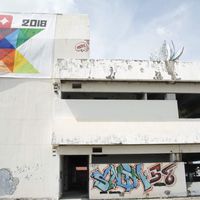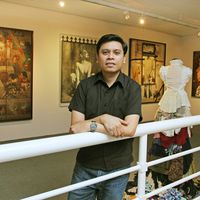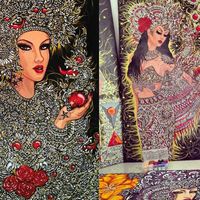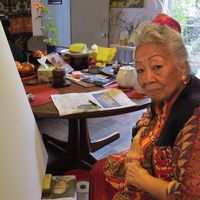Women and the Earth: Interview with Pinaree Sanpitak
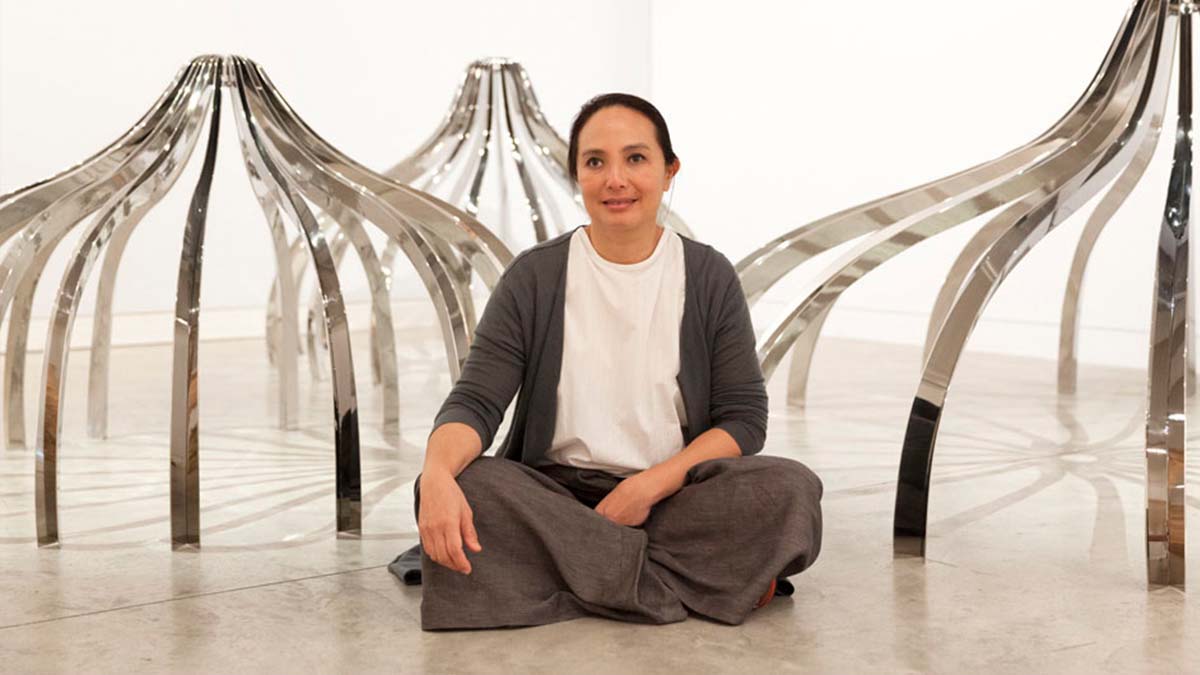
As part of culture360 recent Call for articles, Naima Morelli interviewed Pinaree Sanpitak, one of the most compelling and respected Thai artists of her generation.
“My works stem from personal experiences so naturally whatever’s around me would seep into my works,” says leading Thai artist Pinaree Sanpitak.
With a deep knowledge of materials, as well as a strong conceptual vision, her artworks address motherhood, womanhood, and a deep investigation of the self – often with references to her native Thai culture.
An example of this is her famous “breast stupas”, which are sculptures resembling both bosoms, as well as the stupa, a sacred hemispherical structure intended to contain the Buddha’s relics and to be used as a place of meditation. Another motif of her practice is the "Ma-lai", namely the floral garlands which play a symbolic role in Thai ceremonial occasions from birth to death. It is an art form taught initially to women in the Thai royal court, who created intricate designs of great refinements, and in Sanpitak’s work, they take different meanings, from the feminist to the ecological.
Sanpitak was one of the few Southeast Asian artists selected by Cecilia Alemani to be participating in the Venice Biennale at the beginning of this year and is currently showcasing her latest work at the much-awaited Bangkok Art Biennale.
Naima Morelli spoke with the artist to get a closer look into her art practice and future projects.
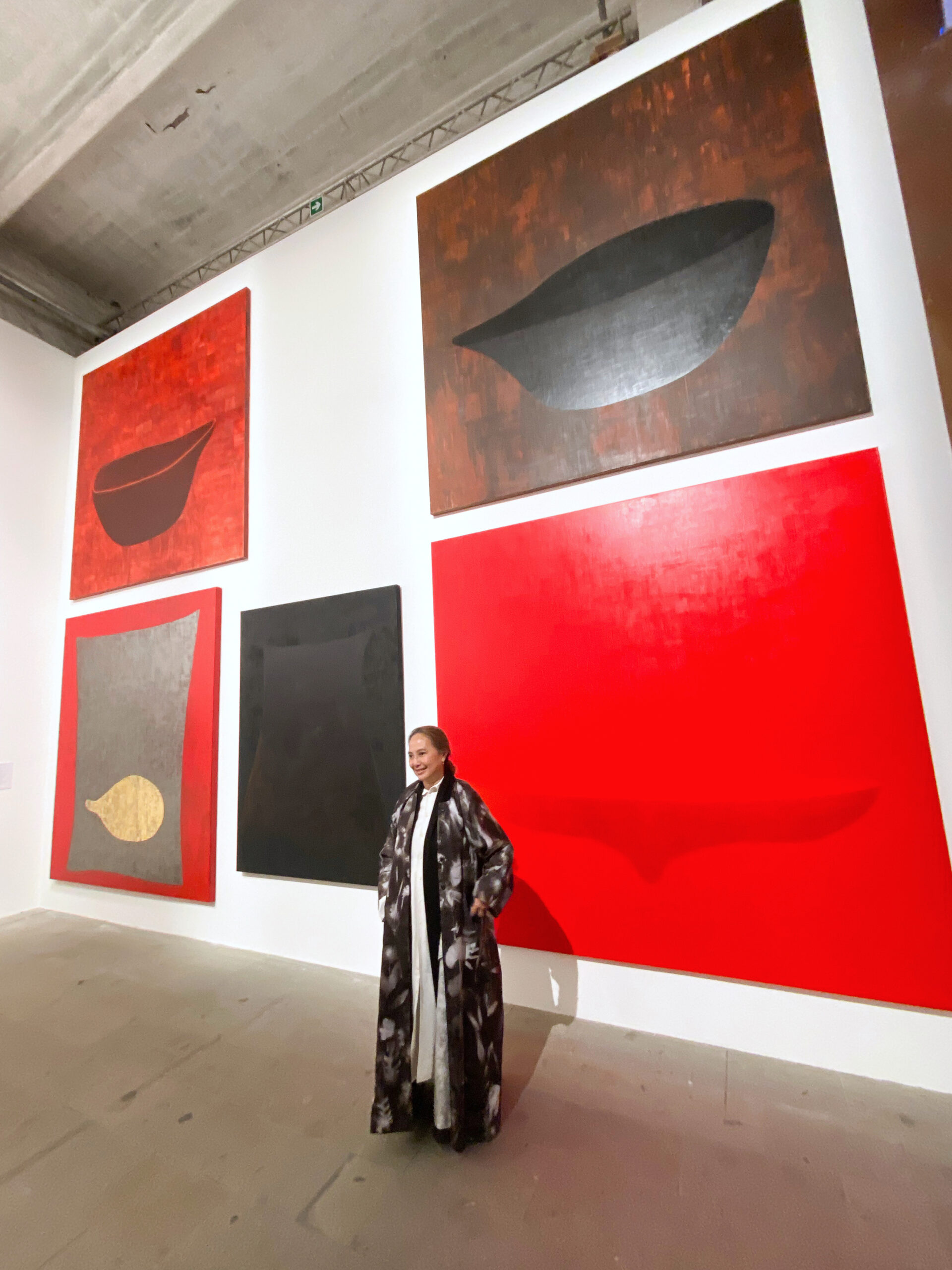
You were one of the few Thai artists to join this year’s Venice Biennale. What did this participation mean to you?
I was super excited when I received the invitation and had so much fun working on the paintings for the large wall I was allocated. The challenge was that the works would have been hung salon style. I didn’t have any information about the other works around it or the location of the wall in the room. I just had to make my wall work. We selected 5 works from 11 paintings. I wanted to create a fluid connected story. I was given carte blanche on the subject matter as all my works correlate with curator, Cecilia Alemani’s themes: the Bodies and their Metamorphosis, the Body and Technologies, the Body and the Earth.
1. Pinaree at Venice Biennale © Courtesy of the artist and Yavuz Gallery
How did studying at the University of Tsukuba in Ibaraki, Japan, influence your approach to composition, which is often minimal and zen-like?
When working I don’t really think whether this has elements from Thailand or Japan or elsewhere. I was in Japan from age 19 to 23. So certainly they are my foundation years and naturally embedded in me. I was the only foreign student in my class. My professors allowed me freedom in what I wanted to pursue and I am grateful, as it has set me off with confidence and a very open mindset. Concepts, materials, and projects always evolve naturally for me. It can be deliberately reduced and also layered and complex.
Your work is heavily focused on the profound significance of womanhood. How did the birth of your only child affect the early development of your imagery, and why did you remain tied to motherhood symbols ever since?
The first Breast Works from 1994 were intended as a monument for womanhood not just motherhood. I wanted to use a part of the body that differentiate between the gender and chose the breasts as they were a very active part of my body at the time. I find breasts beautiful in their form and context. They are delicate and unpredictable. Givers and receivers. I became fascinated and wanted to explore it further in all aspects, all angles. They are very personal so you can also see them as portraits. They are about human beings, not necessarily just about the mother.
What’s the importance of the choice of materials in your practice?
My inspiration stems from a lot of sources and one of them is material. A lot of times I am drawn to the materials not knowing how I would use them or how I would interpret them in my language, and I would have to work it out, sometimes for a number of years. Sometimes the materials are incorporated into a certain structure or form that exists. Sometimes the materials lead me to new ideas.
How do you conceive your more interactive installations, versus painting? Do they come from different parts of your brain/spirit?
I always work between two and three dimensions. The works bounce off from one another. I commenced working on interactive installations around the year 2000 as I was interested to explore sensory perceptions starting with the sense of touch through my installation piece Noon-Nom. Tactile is a word often used to describe my works. With Noon-Nom I deliberately allowed visitors to have physical contact with the artworks. Sound and movement followed in Temporary Insanity (2004). Food in Breast Stupa Cookery (2005) and so on. And in between, I would be drawing or painting. I don’t separate my brain (she smiles).
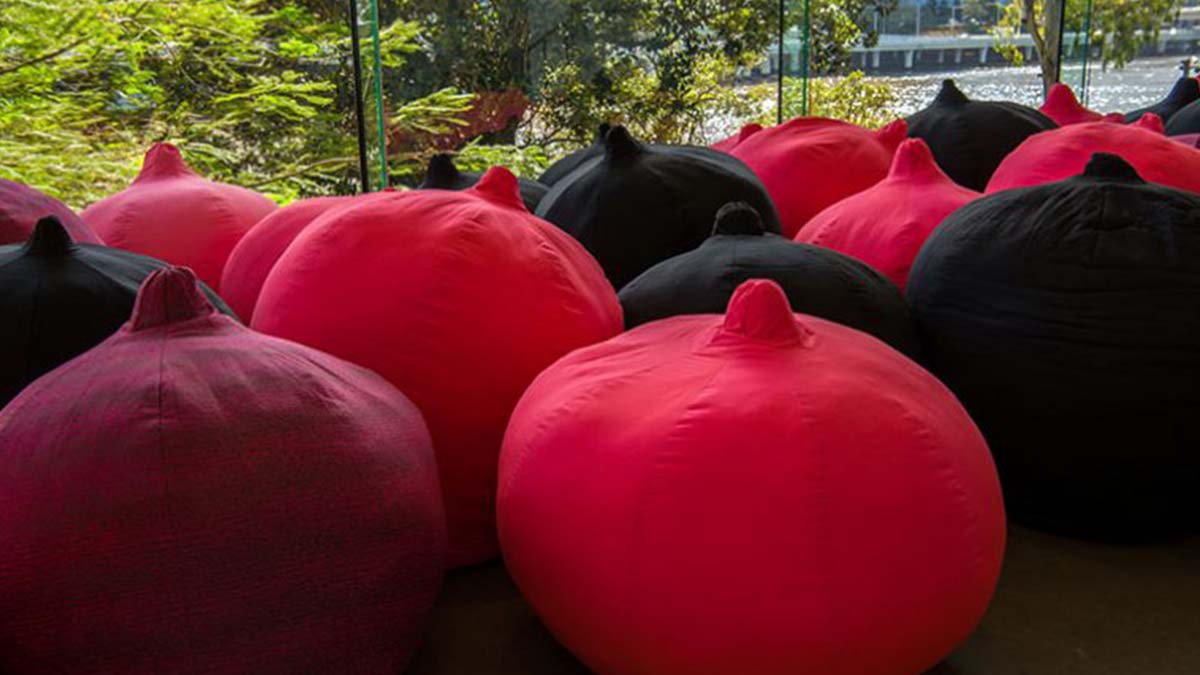 |
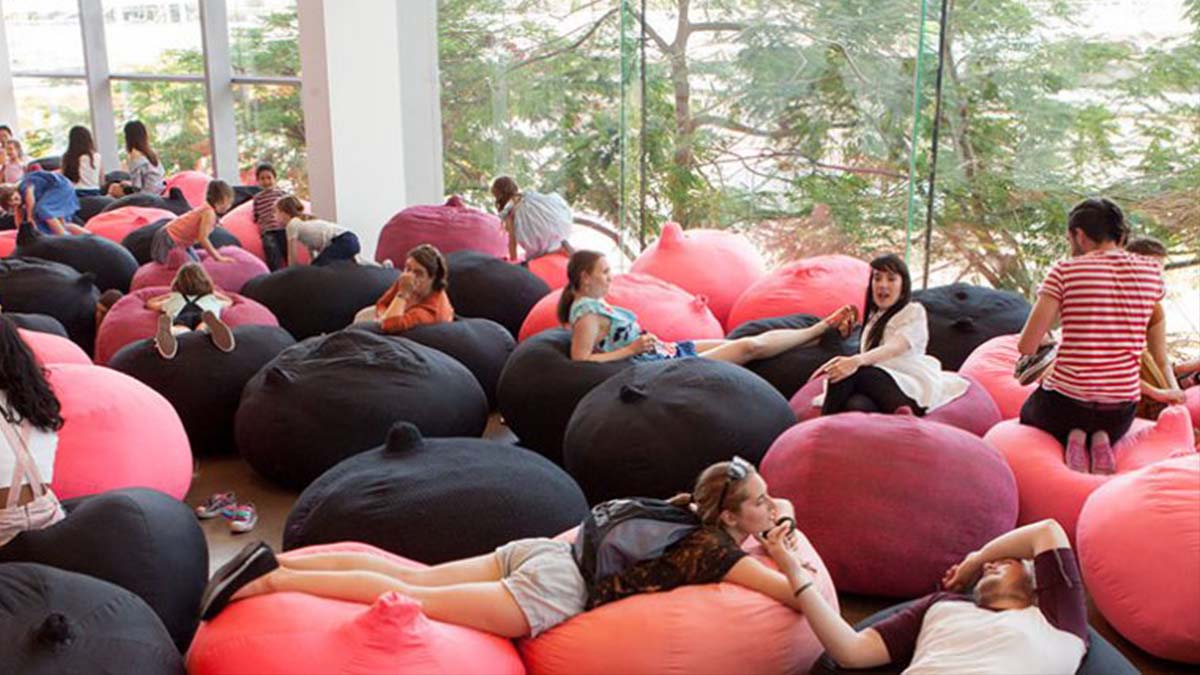 |
Your series Ma-lai, references floral garlands served in Thailand as a symbol of significant occasions or passages of life. How did you connect this with environmental issues in your installations?
I incorporated elements from the garden into my works with dried flowers from my garden in my paintings or the outdoor work Breast Stupa Topiary (2013). With Ma-lai I wanted to create a work with one module that can be extended. Ma-lai evolves into three different elements with the Ma-lai in toile, then the paintings in acrylic with pencil and dried flowers, and the cast metal sculptures with actual flowers. Each one portrays certain mindsets and emotions. Ma-lai is more about a gesture of respect. A memory. There is a struggle, but hope.
 4. Pinaree Sanpitak’s "Ma-lai" © Courtesy of the artist
4. Pinaree Sanpitak’s "Ma-lai" © Courtesy of the artist
A more recent project is the work The Women and the Earth, presented in the three-artist show A Spirit of Gift, A Space of Sharing at Hancock Shaker Village in the US. Can you tell me about this work?
My works are various breast stupa works. I was interested to work with the Hancock Shaker Village project because of their fundamental beliefs, aesthetics and craftsmanship. The group balances out the gender roles in an exemplary manner in line with their principles. These are the keywords from a video documentary that stayed in my mind: "Perfection, No Ornament, Spiritual, Deliberate Simplicity, No Fight against Gravity, No Dirt in Heaven, Flat Broom."
Due to Covid-19, I did not pursue the survey trip as intended, therefore I planned the whole project so that it was flexible enough in case I cannot be present, but it is still immersive and collaborative. “Breast Stupa” hand-torn and stacked paper sculptures of various sizes, colours, and shapes are placed in the kitchen, dining hall, medicinal herbs room and beside a red cloak in the “Brick Dwelling” to create a dialogue with the Shakers’ aesthetic and way of life. With The Affairs of Breast Stupas placed indoors, outside Breast Stupa Topiary are built locally in collaboration with Edward Martin and installed near the vegetable gardens. The Shakers come from an agricultural background and the working farm which started in 1783 continues. Breast Stupa Topiary connects directly with the Shakers’ earth and the seeds. On the opening day invited guests dined in the original 1830 dining room in the Brick Dwelling with Chef Josh Kelly’s “Breast Stupa Cookery”. During the 6-month course of the exhibition, he creates meals inspired by the concept of “Breast Stupa Cookery” and incorporated home-grown vegetables. The three “breast stupa” projects bring together the sacred and sensuality of the Shakers’ history, beliefs, way of life, and craftmanship. Sharing and learning.
 5. Pinaree Sanpitak’s "A Spirit of Gift, A Space of Sharing" at Hancock Shaker Village © Courtesy of the artist, picture by Marc Freedman
5. Pinaree Sanpitak’s "A Spirit of Gift, A Space of Sharing" at Hancock Shaker Village © Courtesy of the artist, picture by Marc Freedman
Can you tell me about the new works you currently have at the Bangkok Art Biennale?
I will be presenting two sound interactive installations, Temporary Insanity (2004) and Anything Can Break (2011). This will be the first time the two works are exhibited together, but I have invited two young Thai composers to create new sounds for Anything Can Break, so I suppose you can say the piece is new. They both have been installed in various locations. It is good to bring them out for another run as they have mechanics and components that need to be switched on from time to time. One is set on the floor, one hangs over your head. I think it goes well with this year’s BAB 2022’s theme, CHAOS: CALM. Temporary Insanity moves when triggered by clapping hands or stomping feet. Anything Can Break emits sounds when triggered by body movements below.
About the Author
Naima Morelli is an arts writer and journalist specialized in contemporary art from Asia-Pacific and the MENA region. She has written for Al-Jazeera, ArtAsiaPacific, CoBo Social, Internazionale and Il Manifesto, among others, and she is a regular contributor to Plural Art Mag, Middle East Monitor and Middle East Eye, as well as writing curatorial texts for galleries. She is the author of three books on Southeast Asian contemporary art.
Reach out: contact@naimamorelli.com
Similar content
16 Jun 2014
posted on
18 Aug 2013

